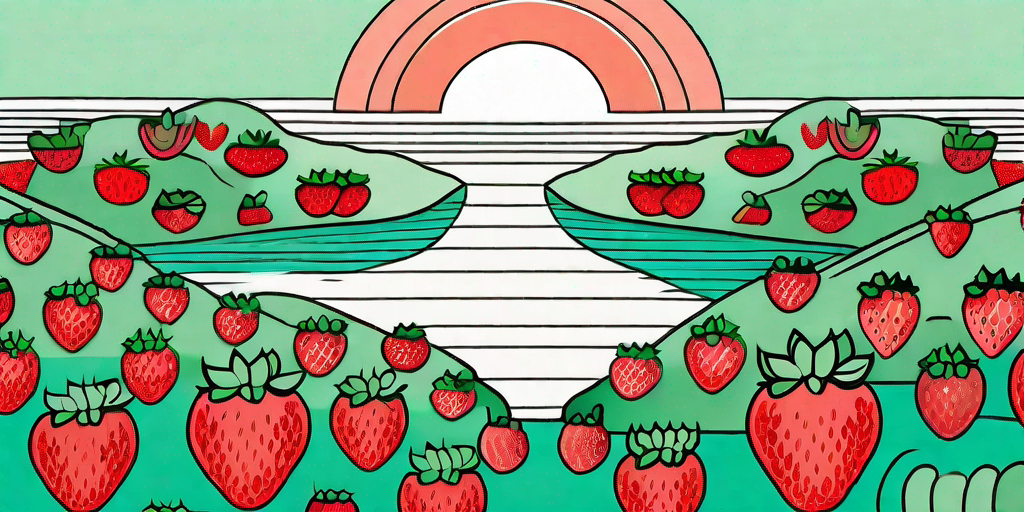
Strawberries, those little red gems of sweetness, have always been a crowd-pleaser. But have you ever wondered about the journey they take from the farm to your fruit bowl? Welcome to the delicious world of Strawberry Seascape, a variety that's as captivating as its name suggests. Let's embark on a sweet escape together, shall we?
The Berry Basics
What is a Strawberry Seascape?
Strawberry Seascape is a day-neutral variety of strawberry, which means it doesn't rely on the length of daylight to produce fruit. Instead, it generously offers its sweet bounty from spring to fall, making it a favorite among both growers and consumers. Its large, firm berries are known for their exceptional flavor and aroma, making them perfect for fresh eating, jams, and desserts.
But the Strawberry Seascape is not just about the taste. Its aesthetic appeal is equally impressive. Imagine a sea of lush green leaves, dotted with white blossoms and vibrant red berries. It's a sight that can make any gardener's heart flutter with joy.
Where Does it Grow?
Strawberry Seascape is a hardy variety that can adapt to a wide range of climates. It thrives in USDA hardiness zones 4 to 8, which means it can withstand winter temperatures as low as -30°F. So whether you live in the chilly Midwest or the sunny West Coast, you can enjoy the sweet delight of growing your own Strawberry Seascape.
However, like any other plant, it has its preferences. It loves well-drained, loamy soil and full sun exposure. So if you're planning to grow it in your garden, make sure to choose a spot that gets at least six hours of sunlight a day.
How to Grow Your Own Strawberry Seascape
Planting the Strawberries
Planting Strawberry Seascape is a fun and rewarding experience. The best time to plant is in early spring, as soon as the soil can be worked. Start by preparing the soil. Add compost or well-rotted manure to improve its fertility and drainage. Then, dig a hole that's wide and deep enough to accommodate the roots of the plant.
Place the plant in the hole, making sure the crown is level with the soil surface. Backfill the hole and firm the soil gently around the plant. Water thoroughly and mulch with straw to conserve moisture and suppress weeds. Repeat the process for each plant, spacing them about 12 inches apart.
Caring for the Plants
Strawberry Seascape is a low-maintenance plant, but it does appreciate a little TLC. Water it regularly, especially during dry spells. Feed it with a balanced fertilizer in early spring and again after the first harvest. Prune off any dead or diseased leaves to keep the plant healthy.
As for pests and diseases, keep an eye out for common strawberry problems like slugs, birds, and powdery mildew. Use organic methods to control them, such as handpicking, bird netting, and baking soda spray.
Harvesting and Enjoying the Fruits of Your Labor
When and How to Harvest
Strawberry Seascape starts producing fruit about 30 days after flowering. The berries are ready to harvest when they are fully red and come off easily when gently tugged. Harvest in the cool of the morning and place the berries in a shallow container to prevent bruising.
Remember, the fruit doesn't ripen after picking, so be patient and let nature do its magic. The wait will be worth it, we promise!
Delicious Ways to Enjoy Your Harvest
Now comes the best part - enjoying your harvest. Strawberry Seascape is delicious eaten fresh, but it's also great in a variety of dishes. Toss it in a salad, blend it in a smoothie, bake it in a pie, or make it into jam. The possibilities are endless!
And if you have a bumper harvest, don't worry. You can freeze the berries for later use. Just wash them, remove the caps, let them dry, and pop them in the freezer. They'll retain their flavor and nutritional value for up to a year.
Frequently Asked Questions
- Can I grow Strawberry Seascape in a container?
Absolutely! In fact, it's a great option for those with limited garden space. Just make sure to use a container that's at least 12 inches in diameter and has good drainage.
- How long does a Strawberry Seascape plant live?
With proper care, a Strawberry Seascape plant can live and produce fruit for up to five years. However, the yield tends to decrease after the third year, so it's a good idea to replace the plants every three to four years.
- Do I need to plant more than one Strawberry Seascape for pollination?
No, Strawberry Seascape is self-pollinating, which means it doesn't need another plant to produce fruit. However, planting more than one can increase the yield and the size of the berries.
So there you have it, folks! A comprehensive guide to the delicious world of Strawberry Seascape. Now, what are you waiting for? Grab your gardening gloves and let's get planting!











